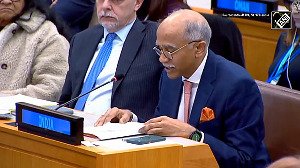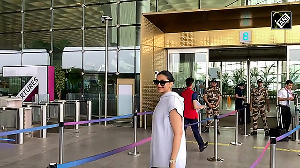The Naxal ambush on Wednesday has highlighted what is seen as the last major challenge for security forces in Chhattisgarh -- foiling Improvised Explosive Device (IED) attacks in the forested tri-junction in Bastar region.

Security officials cite the lack of foolproof technology to detect IEDs and the increasing desperation of Naxals, who are avoiding direct combat with the forces involved in operations to completely stamp out Left Wing Extremism (LWE) violence in the state, for such incidents.
The latest attack was the biggest strike by the Naxals on the security forces in the state in the last two years.
Ten district reserve guard (DRG) personnel and a driver were killed when the extremists blew up their vehicle in the Aranpur area of Dantewada district.
The explosion created a nearly 10-ft deep crater, splitting the road and completely destroying the vehicle.
The geographical tri-junction of Chhattisgarh, Telangana and Odisha located right at the southern tip of Sukma district in the south Bastar region is an area that witnesses the maximum number of such incidents including the deadly 2010 Maoist ambush in Dantewada where 75 CRPF and one Chhattisgarh police personnel were killed.
The Union government has maintained that Left Wing Extremism has almost been wiped out in Jharkhand and Bihar due to sustained operations by security forces, noting that Naxal violence incidents have come down by 77 per cent in just over a decade.
However, security officials say the menace of stealthily placed IEDs, especially in the border areas of south Chhattisgarh, "continues to pose a challenge" to them.
"A general alert was issued to the security agencies stating that the Naxal-sponsored TCOC period is on and hence they should be alert while conducting operational and administrative tasks.
"Unfortunately, the Naxals were successful in trapping the DRG vehicle in Dantewada. The exact reasons behind this incident are being investigated," a senior security officer in Delhi told PTI.
The TCOC is an armed operation undertaken by the Maoists in March-June to strengthen their cadres and launch major attacks on security forces as forests are devoid of green cover, thereby increasing visibility and line of sight to ambush.
These areas are controlled by the Dandakaranya Special Zonal Committee of the Maoists and led by the 'elusive' Hidma, stated to be the commander of the PLGA battalion no. 1 which is accused by police agencies of planning and executing hundreds of ambushes against the forces over the last two decades.
The forces are trying to "capture, dominate and hold" these areas by constructing remote bases and roads. The Central Reserve Police Force (CRPF) has set up as many as 15 forward operating bases in Chhattisgarh over the last three years and some more are in the offing, a security officer based in Bastar said.
These bases are being created so that small units of commandos based here can effectively hit the Naxals in their core areas and secure these locations for government agencies to launch development works, the officer said.
The remote locations, dense forests and weak mobile phone connectivity are other major hurdles for the forces and government agencies that are operating in these areas.
"However, continued efforts are on and we hope to achieve good results including ruling out the possibility of deadly attacks and ambushes on police patrol parties," the second officer quoted above said.
The IEDs continue to be a cause of big trouble because of two factors, a CRPF officer said.
The first is that as Maoists have run out of sophisticated guns, rifles and ammunition. They choose to not fight a one-on-one battle but launch surprise attacks, the officer said.
They are not always successful as the forces have learnt their lessons of not taking the 'beaten track' now, but whenever they are successful, a number of security personnel are either killed or maimed, the officer said.
"The second issue is that we still do not have foolproof technology to detect the IEDs. They are placed under blacktop roads, or hidden beneath culverts or bridges and are triggered by a person sitting far away as soon as a security vehicle or patrol is detected," he said.
Many IEDs explode even when the troops are on foot and their trigger mechanism gets activated just due to the pressure of the feet. These incidents have injured more than 100 personnel over the last two years, the officer said.
"The south Bastar region and its bordering areas and the IEDs are the last Maoist bastions to be breached. The forces are working towards this goal," he said.
The Union government had told Parliament in December 2022 that incidents of Naxal violence have reduced by 77 per cent from the high of 2,213 in 2010 to 509 in 2021.
The resultant deaths (civilians and security forces) reduced by 85 per cent from the high of 1,005 in 2010 to 147 in 2021, Minister of State for Home Nityanand Rai had said in a written reply to Lok Sabha, adding that the declining trend continued in 2022.
The minister also said the geographical spread of the violence has also significantly reduced and only 191 police stations of 46 districts reported LWE-related violence in 2021 as compared to a high of 465 police stations of 96 districts in 2010.
The decline in the geographical spread is also reflected in the reduced number of districts covered under security related expenditure scheme and the number of these districts reduced from 126 to 90 in April, 2018 and further to 70 in July 2021, data provided by him had said.
The number of districts contributing approximately 90 per cent of the LWE violence, categorised as most LWE-affected districts, also came down to 30 from 35 in 2018 and further to 25 in 2021, he said.











